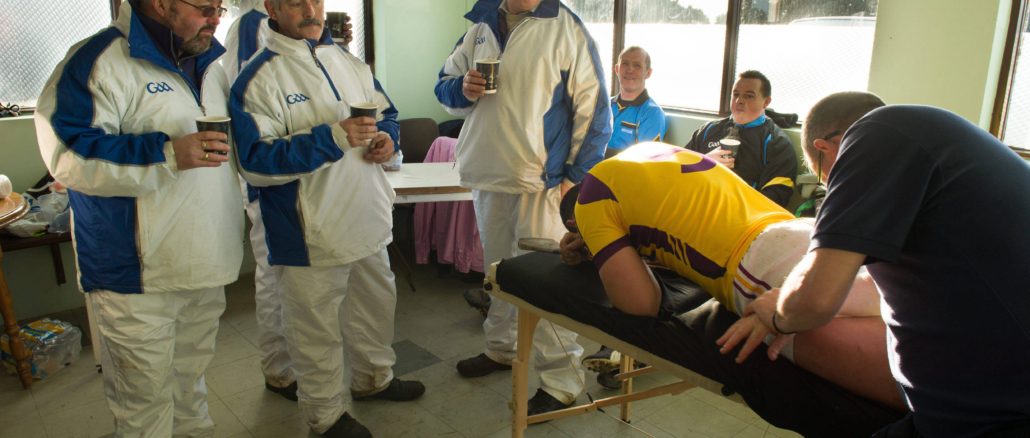
Hamstring injuries are among the most prevalent and painful injuries in any sport. They have derailed seasons and ended careers. One of the easiest body parts to damage, the hamstring becomes strained or torn when a player simply stretches awkwardly.
Like metatarsal and ACL, hamstring has been reduced to a buzz word that fans and coaches alike throw around without really understanding the what it is or severity of an injury to it.
At a local level, six of the 28 squad members of the Louth senior hurlers suffered hamstring injuries during the 2015 season.
Statistics confirm that hamstring injury is the most prevalent in sport today. Of the 98 Premier League footballers listed as injured on Physioroom.com, 27 are suffering from hamstring injuries (28%).
A study carried out by UCD academics and students in 2013 consisting of 2,500 GAA players, highlighted that 25% suffered hamstring injuries in a playing season, with 62% suffering a recurrence of the same injury.
Bryan Heiderscheit, a professor at the University of Wisconsin and leading expert on the hamstring injury, explained the process of the hamstring tear in a 2010 study of American football players.
“The occurrence of hamstring strain injuries during high-speed running is generally believed to occur during the terminal swing phase of the gait cycle.” he said.
“As the leg straightens upon contact with the ground, the biceps femoris, the longest of the hamstring muscles (“which has a tendency to be more incurred than the other two hamstring muscles – semimembranosus and semitendinosus”) becomes elognated. It is at this point that the leg is most vulnerable to tear.”
Physiotherapist Charles Markey, who specialises in neuromusculoskeletal dysfunction, feels that GAA players not getting requisite recovery time is a leading cause of injury. “A player working in an office from nine to five will obviously be stiffer and have a predisposition to injury.
Peter Browne, a third year DCU student of Sport Science and Gaelic footballer for his local club St. Fechin’s in Co. Louth feels that there is a lack of education on treating injuries in the GAA due to the volunteer nature of the association.
“I suffered many hamstring injuries while I was in secondary school. The general consensus was ‘rest and when it feels ok, comeback’, when in reality you need to be getting back to pre-injury flexibility and power.”
Former Clare senior footballer Aidan Greene offered a more practical reason on the growing trend of muscular injuries.
“Lads used to do a lot more manual labour. Teenagers now tend to spend lots of time sitting around watching television. They don’t develop key muscles as guys used to. This combined with increased intensity of training leads to injuries.”
It’s always difficult to compare professional and amateur athletes due to lifestyle, however, the causes for injury are similar. Eoghan O’Neill, former physio of the Armagh and Mayo senior footballers, detailed the main injury causes.
“Players that have previously suffered from hamstring injury and older players are particularly susceptible to this injury.”
Core strength is a term often bandied around in injury prevention, but O’Neill feels the term is inadequate in this case. He highlighted the importance of Lumbopelvic control, the ability to maintain stability between the vertebrae through range.
“Lumbopelvic control in a player really determines whether or not they manage to stay free of hamstring problems. Lack of flexibility would be down the line in terms of primary cause.”
“Marshmallow asses” is a term frequently coined by DCU physiotherapist Miriam Downey as a leading cause of hamstring tears.
“In many cases the gluteal muscles are very weak, and in some cases not working at all. The hamstring muscles have to compensate and therefore are overworked.”
She remains unconvinced that external factors such as playing surfaces play a significant role in injury.
“Wet pitches with mud stuck to the boots obviously won’t help, but in-game injury is much more heavily influenced by fatigue.”
Professional sports teams being run as businesses largely dictates the seriousness with which injury prevention and rehabilitation is treated.
“When you’ve paid millions for players, the last place you want them is constantly perched up on the physio’s bed. They’re needed on the pitch offering a return on your investment,” concluded Markey.
Ex-Liverpool player Vegard Heggem knows better than most that hamstring injury can dismantle a career. Heggem seemed destined for stardom, however recurring hamstring injuries meant Liverpool opted against renewing his contract in 2003.
No club was willing to offer such an injury prone player a contract. He retired shortly after. He is now the manager of a Norwegian salmon fishing business, Aunan Lodge.
There is a near-universal agreement among physiotherapists that there’s been mammoth changes in the way with which the hamstring injury is dealt. Eccentric strengthening (strengthening of muscles when elongated) is the requirement: dead-lifting and nordic hamstring curls are the means.
Thundery Termonfeckin on a terrible Tuesday appears a world far removed from the glitz, the glamour and the prestige of an illustrious night of European football at Anfield or the Bernabeu.
The destructive hamstring tear, however, is not picky about where it decides to rear its unwanted head. Education of injury prevention and rehabilitation, discipline in strength training and a healthy lifestyle without a good balance between work and rest, is a player’s best bet at eluding ‘the curse of the hammy.’




Leave a Reply